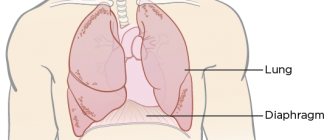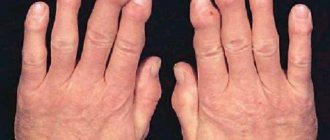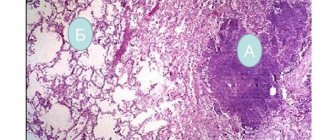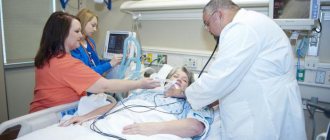A condition in which the rhythm, frequency and depth of breathing is disrupted, and a feeling of air deficiency occurs, is called shortness of breath. The causes and treatment of this disorder can be very diverse. Shortness of breath can occur under various conditions. So, for example, there is shortness of breath when talking, shortness of breath when lying down, after sleep, shortness of breath at rest, etc. The breathing of a person with shortness of breath is frequent and noisy; it is these manifestations that give others reason to assume the presence of shortness of breath. Shortness of breath can be a consequence of quite serious diseases, therefore, when it appears, it is necessary to contact a specialist as quickly as possible, who will competently explain what shortness of breath is and how it manifests itself, and also prescribe a comprehensive diagnostic examination to identify the causes of its occurrence.
The Therapy Center of the Yusupov Hospital offers high-quality diagnostics and effective treatment of diseases accompanied by shortness of breath. If necessary, a pulmonologist can be called to your home.
Types of shortness of breath
Shortness of breath can be of several types:
- inspiratory (shortness of breath while inhaling), expiratory (during exhalation) and mixed (with difficulty in inhaling and exhaling);
- tachypnea (increased shallow breathing) and bradypnea (decreased breathing);
- physiological - transient, reversible intensification of breathing (shortness of breath during physical exertion). The causes of shortness of breath in this case are that it is an adequate adaptive response to stress, injury, or an objectively low level of oxygen in the inhaled air;
- pathological (in case of airway obstructions due to bad habits, cardiovascular failure, obesity, lung diseases, hematopoietic system, etc.).
Why does shortness of breath occur?
If a person suddenly develops severe shortness of breath, the reasons can be very diverse. Most often it is caused by the following conditions:
- cardiovascular diseases – due to these pathologies, blood circulation is impaired. Internal organs suffer from a lack of oxygen, and carbon dioxide accumulates in the blood. The body’s reaction to this condition is increased breathing: a larger volume of air is pumped through the lungs per unit of time. In the supine position and after physical activity, shortness of breath associated with heart pathology occurs or intensifies. Severe shortness of breath occurs with the patient sitting or half-sitting. This kind of shortness of breath is characterized by difficulty breathing;
- diseases of the respiratory system - the appearance of shortness of breath is associated with obstacles to the passage of air through the respiratory tract (for example, narrowing of the lumen of the bronchi). Therefore, shortness of breath is considered a typical symptom of bronchial asthma. With this disease, the patient experiences difficulty in exhaling. In addition, shortness of breath occurs in cases where the respiratory surface of the lung tissue is reduced. Such a decrease is accompanied by an increase in the intensity of lung function, i.e. frequent inhalation, which is necessary to maintain the required amount of oxygen entering the blood. The list of pathologies of the respiratory system accompanied by shortness of breath includes neoplasms, pneumonia, chronic obstructive pulmonary disease, etc.;
- anemia - even with normal activity of the lungs and heart, a deficiency of hemoglobin and red blood cells leads to insufficient provision of the organs with the necessary amount of oxygen. To compensate for this disorder, the body increases its breathing rate;
- neuroses and panic attacks - in these cases, clinical examinations do not reveal the presence of cardiovascular and pulmonary pathologies, but subjectively the patient suffers from lack of air, and the appearance of psycho-emotional changes provokes increased breathing, which causes shortness of breath;
- various tumors – shortness of breath occurs with a tumor of the thalamus, intestinal tumors, etc.;
- problems with the gastrointestinal tract. For example, hoarseness, cough, shortness of breath with esophagitis are characteristic symptoms;
- obesity and diabetes are common causes of shortness of breath.
Causes of lack of air
Difficulty in inhaling in healthy people is caused by a discrepancy between the amount of air inhaled and the need for oxygen. Such shortness of breath is disturbing when doing hard work, during intense training, climbing mountains, and in stressful situations. The appearance of a feeling of lack of oxygen is facilitated by wearing tight clothes, belts and corsets that interfere with normal breathing. In older people, as a result of age-related changes in blood vessels and heart, shortness of breath may appear with minimal exertion. The feeling of lack of air also manifests itself in a number of conditions and diseases.
Pregnancy
Shortness of breath with a feeling of insufficient inspiration occurs mainly in the 2nd half of the gestational age. As the uterus enlarges, the diaphragm is pushed upward, which limits the depth of breathing. The longer the pregnancy, the more often a lack of oxygen is felt, even with calm walking and minor exertion. In this case, the frequency of respiratory movements at rest increases to 22-25 breaths per minute. When shortness of breath occurs, a pregnant woman is usually bothered by slight dizziness, sometimes flashing “spots” and darkening in the eyes.
The symptom often appears and is more pronounced in patients who are carrying a large fetus, multiple pregnancies, or suffer from polyhydramnios. An aggravating factor is inferior vena cava syndrome during pregnancy. With aortocaval compression, in addition to shortness of breath, due to limited mobility of the diaphragm, women experience difficulty breathing and lack of air when lying on their back. Respiratory distress is combined with sudden weakness, severe dizziness and even fainting.
Pleurisy
Increasing shortness of breath with difficulty breathing is a characteristic sign of inflammation of the pleura. Respiratory disorders are caused by intense pain during dry pleurisy, accumulation of fluid in the pleural cavity - during an exudative, purulent, hemorrhagic process. Lack of air becomes the result of shallow, gentle breathing: in order to reduce acute stabbing or dull drawing pain over the affected area, the patient limits the volume of respiratory movements. Often shortness of breath is accompanied by a painful dry cough, fever, and chills.
Lung diseases
With inflammatory and diffuse damage to the lung tissue, the feeling of lack of inhaled air is associated with the exclusion of part of the lung from the respiratory process, limiting its mobility and elasticity. Patients complain of incomplete inspiration, weakness, fatigue, and dizziness. Signs of pulmonary dyspnea usually include:
- Lobar pneumonia
. Shortness of breath begins suddenly, simultaneously with a sharp rise in temperature to 39 ° C and above, severe headache, pain in the affected part of the chest, weakness, dry and later wet cough. Daily temperature fluctuations of 0.5-2 °C and profuse sweating are typical. - Interstitial pneumonia
. The feeling of “incomplete inspiration” appears gradually, first during exercise, later at rest. Lack of oxygen often worries you at night. Shortness of breath is accompanied by a dry cough, disrupts sleep, and provokes fatigue during the daytime. In an acute process, changes in breathing resemble the symptoms of lobar pneumonia. - Primary bronchopulmonary amyloidosis
. Difficulty in inhalation is pathognomonic for the deposition of amyloid in the wall of the trachea and large bronchi, while the patient’s heavy wheezing can be heard at a distance. If the alveoli are damaged, lack of air with a dry cough bothers you at the slightest movement, talking, or at rest. At the same time, due to damage to the heart and blood vessels, pressing pain occurs in the left chest, and the legs swell noticeably. - Pulmonary tuberculosis
. Lack of oxygen, causing shortness of breath, is characteristic of the primary tuberculosis complex and miliary process. The feeling of incomplete inspiration manifests itself against the background of an unproductive cough, pain in the chest, low-grade or high fever, severe weakness and sweating. In addition, with disseminated tuberculosis, skin cyanosis is pronounced. - Pulmonary zygomycosis
. Shortness of breath is preceded by a short period of severe intoxication with a temperature of 38°C, a dry or unproductive cough, in which blood may be detected. Shortness of breath worries almost constantly, even with complete rest. Difficulty in inhalation is combined with impaired exhalation. Later, severe chest pain occurs, further limiting breathing. - Sclerotic processes
. With diffuse pneumosclerosis, which developed as a result of post-radiation pneumonitis, pneumoconiosis, and other diffuse lung lesions, shortness of breath appears and increases gradually. In the terminal stages, the patient does not have enough air even at rest, due to oxygen deficiency, the skin becomes bluish, and the fingers are shaped like drumsticks (Hippocratic fingers).
Laryngeal stenosis
Most often, inhalation difficulties are caused by diseases in which, as a result of damage to the mucous membrane and vocal cords, obstacles are formed in the path of the movement of air masses. Dyspnea of laryngeal origin is often characterized by a feeling of limited air flow into the airways, wheezing, noisy breathing (stridor). The symptom is observed in the following pathological conditions:
- Acute laryngeal stenosis
. Difficulty in inhaling, noisy breathing, hoarseness, and hoarseness arise and increase extremely quickly. During inhalation, the intercostal spaces and epigastric region are retracted, the jugular fossae are sunken, and the wings of the nose are inflated. The patient shows anxiety, sometimes agitation, panic, feels the fear of death and, in order to facilitate the flow of air, leans on his hands. Breathing gradually becomes more frequent, becomes shallow, and cyanosis of the face and nail phalanges is possible. Acute stenosis complicates the course of croup, false croup, damage during tracheal intubation, and other pathologies accompanied by laryngeal edema. - Chronic stenosis.
A gradual increase in shortness of breath is typical for benign tumors and cancer of the larynx, laryngomalacia, other anomalies of organ development, laryngocele, neuropathic paresis, and damage to the thyroid gland. Symptoms increase slowly. Shortness of breath against the background of a barking cough and hoarse voice intensifies as the lumen of the larynx narrows, but the patient may not notice it for a long time due to gradual adaptation to hypoxia. In the later stages, the lack of air bothers you at rest; the intercostal muscles and abdominal muscles are actively involved in breathing. Lack of oxygen provokes memory impairment, sleep disturbances, and absent-mindedness.
Foreign bodies in the respiratory tract
When foreign objects enter the respiratory tract, breathing becomes difficult, up to the point of complete inability to inhale. The lack of air feels like suffocation. The patient shows anxiety, takes a forced position, breathes quickly and shallowly (“sobs”). A distinctive feature is the suddenness of the development of symptoms after accidental inhalation of food or small objects. Almost immediately, a paroxysmal cough begins with lacrimation, profuse salivation, and increased formation of nasal mucus. The face becomes purple and bluish.
If a foreign body remains in the respiratory tract, not completely blocking its lumen, extraneous sounds may occur when breathing. Balloting of objects in the lumen of the trachea is accompanied by hissing, buzzing, and whistling. Partial bronchial obstruction is characterized by a remotely audible whistle. At the same time, the intensity of the cough decreases, and mucous sputum with foreign body particles may be discharged. Shortness of breath becomes less frequent, but pain in the neck and chest increases. Subsequently, inflammatory processes occur.
Pulmonary and pleural tumors
Features of inspiratory dyspnea in malignant neoplasia depend on the location of the oncological process. However, in any case, respiratory disorders precede or complement specific symptoms of the disease and general manifestations in the form of fatigue, loss of appetite, and progressive weight loss. The feeling of inadequate breathing may bother patients who develop:
- Pleural cancer
. Shortness of breath caused by limited excursion of the lungs is possible both with a primary tumor and with metastatic damage to the pleural layers. Symptoms increase very quickly. In addition to incomplete gentle inhalation, which provokes a lack of air, there is pain in the affected half of the chest, weakness, and general exhaustion. - Bronchioloalveolar cancer
. Difficulty in inhaling during physical activity, and later at rest, is a late sign of a tumor. Often, shortness of breath develops against the background of a painful dry or profuse watery cough, indicates the presence of respiratory failure and precedes the onset of chest pain.
Heart diseases
Complaints about a lack of oxygen are one of the characteristic signs of cardiac dyspnea, which is detected in cardiac diseases that occur with rhythm disturbances (tachycardia, extrasystole, WPW syndrome) or insufficient blood supply to the myocardium (angina pectoris, unstable angina, other forms of coronary heart disease). The severity of the symptom usually directly depends on the degree and form of heart failure. In mild cases, shortness of breath is felt after moderate physical activity or with strong emotional experiences.
Pathological changes in the respiratory process in chronic heart failure are manifested by a feeling of lack of air and increased respiratory movements when performing simple physical exercises, everyday work, fast and then normal walking, at rest. Patients describe their sensation as a desire to inhale more air “full of the chest,” oh. Typical symptoms include cyanosis (cyanosis) of the nasolabial triangle, nails, swelling of the lower extremities, severe fatigue, complaints of discomfort, heaviness, and chest pain.
Emergency conditions
Shortness of breath with a feeling of acute lack of air is a harbinger or symptom of a number of disorders that require emergency medical care. Together with dizziness, fog and “floaters” before the eyes, “lightheadedness”, it indicates an approaching fainting (syncope). Severe respiratory distress and severe difficulty in inhaling are observed in such acute conditions as:
- Cardiac asthma
. Before or during an attack, there is a retrosternal stabbing, squeezing pain, interruptions in the functioning of the heart, and strong palpitations. An acute feeling of lack of oxygen is accompanied by cold sweat, cough (dry or with hemoptysis), fear of death, and severe weakness. Acrocyanosis is noticeable - blueness of the fingers and toes, lips, tip of the nose, and ears. The skin looks pale with a grayish tint. The patient tries to take a vertical position (orthopnea). Cardiac asthma can manifest itself as myocardial infarction, heart defects, and other cardiac pathologies. - Pulmonary embolism.
In acute cases, shortness of breath occurs suddenly and usually has the character of a painful lack of air with attempts to inhale it. The patient strives to maintain a horizontal position (“lying low”). Breathing quickens to 30-50 or more per minute, in the terminal stage it becomes rare, irregular, noisy (Biot, Cheyne-Stokes type). The skin noticeably turns pale, and as symptoms increase, it becomes bluish, gray-ashy, and in the lightning-fast form, a “cast iron” color. - Pulmonary hemorrhage
. Shortness of breath with a perceived incompleteness of inspiration develops and increases after an attack of persistent cough, at the end of which mucous sputum with scarlet blood or its clots is coughed up. In severe cases, dyspnea is accompanied by profuse bleeding from the respiratory tract, which is preceded by a burning sensation and tickling in the affected part of the chest. Against the background of frequent gurgling breathing, general disorders quickly increase: dizziness, noise in the head and ears. The skin turns pale and becomes covered with cold, sticky sweat, and signs of acrocyanosis are noticeable.
Chest and lung injuries
Respiratory disturbances in thoracic injuries can be either short-term or progressive. Thus, with bruised ribs, transient difficulty in inhaling is secondary and is associated with limitation of respiratory movements due to chest pain when deeply inhaling air. With closed traumatic or spontaneous pneumothorax, complaints of insufficient oxygen supply, rapid breathing, blue lips along with sharp stabbing pain in the chest, radiating to the arm and neck, cold sweat, drop in pressure, subcutaneous emphysema become leading in the clinical picture.
Neurotic disorders
Up to 75% of patients of neurologists and psychiatrists complain of frequent or constant lack of air, a feeling of a “damper” or other obstruction in the chest, making it difficult to breathe fully. Often, patients exhibit concomitant emotional disorders - anxiety, hypochondria, phobias, in particular, fear of death from suffocation. The key features of neurotic shortness of breath are the appearance or intensification after traumatic situations, vivid, figurative descriptions of experiences, and characteristic noise design (groans, groans, sighs). Shortness of breath is especially acute during a panic attack.
With cardioneurosis, somatoform dysfunction of the autonomic nervous system, vegetative-vascular dystonia, a typical combination of difficulty breathing with constant or paroxysmal palpitations, headaches, tingling in the precordial area, chilliness, sweating, and a tendency to turn pale or redden the face. A subjectively felt lack of incoming air (“empty breath”), forcing the patient to breathe frequently, deeply and noisily in the absence of somatic preconditions, is one of the variants of respiratory dysfunction in hyperventilation syndrome.
Shortness of breath in people of different age categories
Shortness of breath can occur in people of all ages, from infants to the elderly.
In children, shortness of breath can be both physiological and pathological. The appearance of physiological shortness of breath is caused by physical exertion or high anxiety, which is considered normal. When the respiratory system is immature, pathological shortness of breath occurs in the infant. How to determine the type of shortness of breath and its causes is decided by the pediatrician, selecting the necessary diagnostic methods.
In old age, people's tolerance to physical activity decreases and the efficiency of the respiratory system decreases. Due to age-related changes, the physical strength of the respiratory muscles decreases, as a result of which gas exchange worsens and normal breathing becomes difficult. In addition, older people tend to have diseases of the cardiovascular system and lungs, which lead to shortness of breath. Most often, they do not pay attention to this symptom for a long time, so the diseases that accompany it are diagnosed at advanced stages. As a result, treatment becomes more difficult, the quality of life and its duration are significantly reduced. So it is better to immediately seek medical help if shortness of breath occurs in older people, without waiting for the condition to worsen.
The best pulmonologists in Moscow - Doctor of Medical Sciences, Professor Alexander Vyacheslavovich Averyanov, Candidate of Medical Sciences Alexander Evgenievich Shuganov are receiving appointments at the therapy center of the Yusupov Hospital. Klina is equipped with innovative high-tech equipment for conducting the most modern diagnostic studies. Thanks to an integrated approach involving specialized specialists in various fields, our doctors identify the exact cause of shortness of breath and select an effective treatment regimen, taking into account the individual characteristics of each patient.
What is shortness of breath in humans: symptoms
The occurrence of shortness of breath in the initial stages of damage to the cardiovascular and respiratory systems is associated with physical exertion (for example, when the patient climbs up the stairs). As the pathology progresses, shortness of breath and fatigue appear even with a slight load (walking on a flat surface, tying shoelaces, etc.), as well as at rest.
Patients perceive shortness of breath quite subjectively. It may be accompanied by the following symptoms:
- difficulty breathing (inhalation/exhalation);
- compression in the chest;
- feeling of congestion in the chest area;
- tightness in the chest;
- feeling of lack of air;
- inability to take a deep breath or exhale completely;
- suffocation.
Shortness of breath as a result of a nervous disorder
Often shortness of breath can appear due to nervous shock. Experiences that make you nervous lead to chest pain, difficulty breathing and intestinal upset.
At the same time, experienced stress or prolonged depression can become a reason for further anxiety associated with the fear of suffocation. Shortness of breath that catches the patient in his sleep can cause nightmares and sensations as if someone heavy was sitting on top of his chest and trying to strangle him. With severe nervousness, a groan is observed that accompanies every breath. Shortness of breath of psychological etiology is called psychogenic. Such conditions need to be treated, starting with an examination of the nervous system and consultation with a psychotherapist.
Shortness of breath: diagnosis
Diagnosis of the underlying pathology that provoked shortness of breath is carried out using the following research methods:
- general examination (general medical examination, counting the frequency of respiratory movements of the chest, listening to the lungs with a phonendoscope);
- general blood test;
- chest radiography;
- computed tomography of the chest;
- spirometry (spirography) – to assess air flow through the respiratory tract and the ability of the lungs to expand;
- tests using a bronchodilator - spirometry is performed before and after inhalation with a bronchodilator drug. This study allows us to evaluate the reversibility of bronchial narrowing;
- bronchoprovocation test - spirometry is performed before and after inhalation of histamine and methacholine. It is carried out to detect increased sensitivity of the bronchi, which causes bronchospasms;
- studies of the gas composition of the blood (the level of tension in the blood of carbon dioxide, oxygen is determined, the saturation of the blood with oxygen is assessed);
- body plethysmography – allows you to evaluate the function of external respiration. It is used to assess all volumes and capacities of the lungs, incl. those that spirography cannot determine;
- electrocardiography (ECG), echocardiography (ultrasound of the heart, echocardiography) - allows you to assess the functional state of the heart and pressure in the pulmonary artery system;
- fiberoptic bronchoscopy is a study that is used to examine the mucous membrane of the bronchi from the inside and study its cellular composition with a special preparation. The use of this method is advisable for patients with an unclear diagnosis. Allows you to exclude other possible diseases with similar symptoms;
- angiopulmonography – during the procedure the blood vessels of the lungs are examined;
- lung biopsy;
- consultations with a pulmonologist, cardiologist.
Shortness of breath: treatment
Pulmonologists at the Yusupov Hospital Therapy Center select an individual drug therapy regimen for each patient, depending on the disease that provoked the onset of shortness of breath.
The clinic’s rehabilitators draw up a plan for physical training and pulmonary rehabilitation to increase the patient’s tolerance to physical activity, and prescribe breathing exercises using various methods (diaphragmatic breathing, inflating balloons, blowing air through a tube, etc.) that train the respiratory muscles.
In severe cases, artificial ventilation is used.
Shortness of breath accompanies pathologies of various organs and systems of the human body. Therefore, each individual case requires specific therapy, aimed primarily at eliminating the underlying disease causing shortness of breath.
How to treat shortness of breath caused by cardiovascular diseases?
Patients with shortness of breath associated with cardiovascular diseases are prescribed therapy, the goals of which are:
- improve oxygen supply to the heart;
- increase cardiac output;
- reduce blood stagnation in the lungs.
The use of nitrates, glycosides, and diuretics is effective. Patients with heart failure are recommended to always have nitroglycerin available, which helps to immediately dilate the blood vessels of the heart muscle.
Oxygen therapy is used to replenish the lack of oxygen in the blood.
How to get rid of shortness of breath: first aid
Providing first aid for shortness of breath to a person suffering from heart disease involves doing the following:
- call an ambulance;
- before the arrival of doctors, it is necessary to ensure the flow of fresh air into the room where the patient is located by opening the window;
- the patient must be seated on a chair;
- remove the tie and scarf from the patient’s neck, unbutton the top buttons on the shirt;
- Place a nitrosorbide tablet under the patient’s tongue and give any diuretic.
How to cure shortness of breath associated with pulmonary diseases?
For shortness of breath caused by pulmonary pathologies, patients are advised to drink plenty of alkaline fluids (except for patients with pulmonary edema).
To relieve bronchospasm, selective β2-adrenergic agonists (salbutamol, fenoterol, terbutaline, formoterol, clenbuterol, salmeterol) are prescribed. M-cholinergic receptor blockers are effective for relaxing the muscles of the bronchi.
Patients suffering from bronchial asthma are prescribed inhalations with NSAIDs and steroid therapy.
Treatment of shortness of breath due to bronchitis involves the use of medications to separate sputum. These include:
- acetylcysteine;
- carbocysteine;
- bromhexine;
- ambroxol.
How to get rid of shortness of breath associated with allergies?
Every person suffering from allergic diseases should know what to take for shortness of breath of this etiology:
- diazolin;
- diphenhydramine;
- suprastin;
- tavegil;
- fenistil;
- claritin;
- desloratodine, etc.
As an additional therapy for shortness of breath caused by allergies, you can use traditional medicine: decoctions of plants that have an expectorant effect (from plantain, pine buds, coltsfoot), as well as hot foot baths.
How to deal with shortness of breath of a psychogenic nature?
Shortness of breath quite often accompanies mental disorders - melancholy, panic attack, depression. Patients suffering from these conditions are prescribed sedatives, antidepressants and tranquilizers. The use of therapeutic hypnosis is also effective. Treatment is prescribed exclusively by a psychotherapist.
Shortness of breath, especially at rest, is an alarming symptom that often manifests quite serious pathologies that require immediate examination and urgent medical care. Therefore, if such a respiratory disorder occurs, it is necessary to urgently visit your doctor. You can make an appointment with a therapist or pulmonologist at the Yusupov Hospital by calling the phone number listed on the clinic’s website.
Causes of shortness of breath – respiratory system disorders
The causes of shortness of breath can be both heart disease and changes in the hematopoietic system. But the examination begins with studying the condition of the respiratory system. First of all, these are the lungs and bronchi. It is important to make sure that the lung tissue is not damaged, that one of the lungs does not contain malignant tumors, and whether the lungs have been subjected to a toxic attack, which can be either chemical poisoning or long-term tobacco smoking.
The development of pneumonia is another factor that provokes shortness of breath. It does not matter what etiology the pneumonia is. It can be either viral or bacterial. And both diseases cause the development of swelling of the lung tissue, as a result of which the organ cannot perform its functions. Many patients with a high percentage of lung damage from pneumonia are forced to be on a ventilator.
The bronchi play an important role in the process of delivering oxygen to the lungs. Each bronchus has a mucous membrane that can react acutely to external stimuli. For example, with bronchial asthma, the inner surface of the bronchi greatly increases in size, blocking the lumen of the tubular organ. It is impossible to take a full breath in such a situation. Another serious condition is bronchospasm, which also makes breathing very difficult. The result is shortness of breath.










